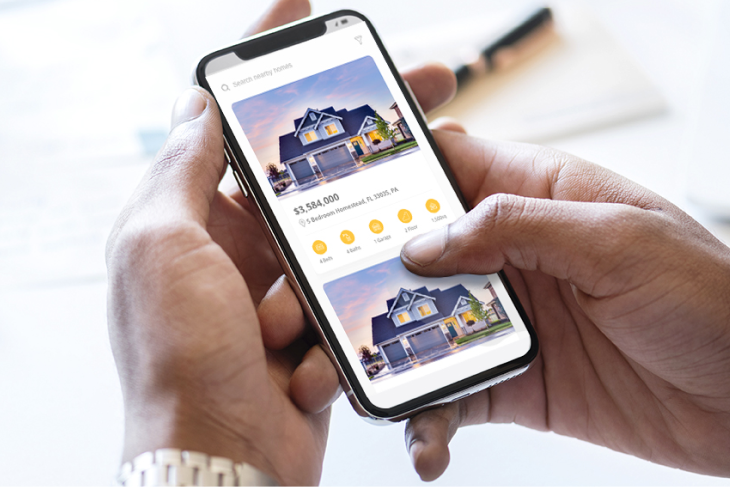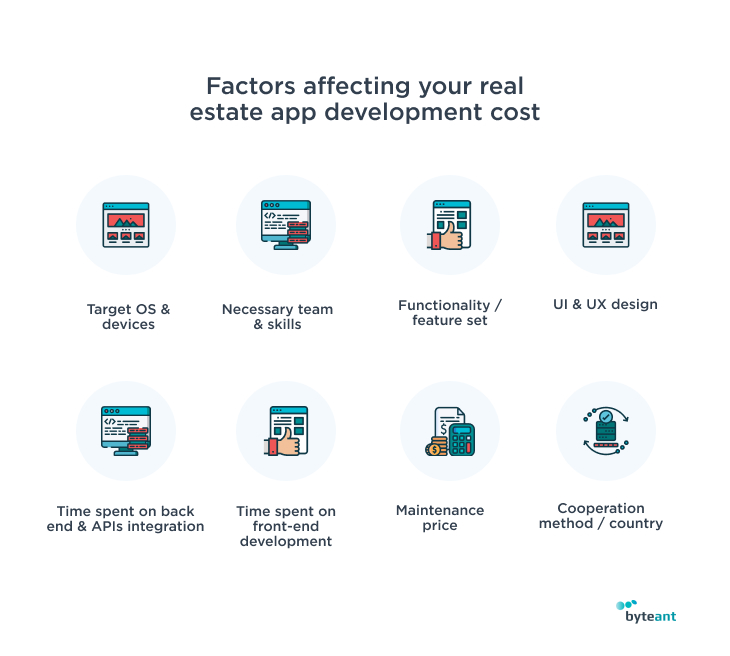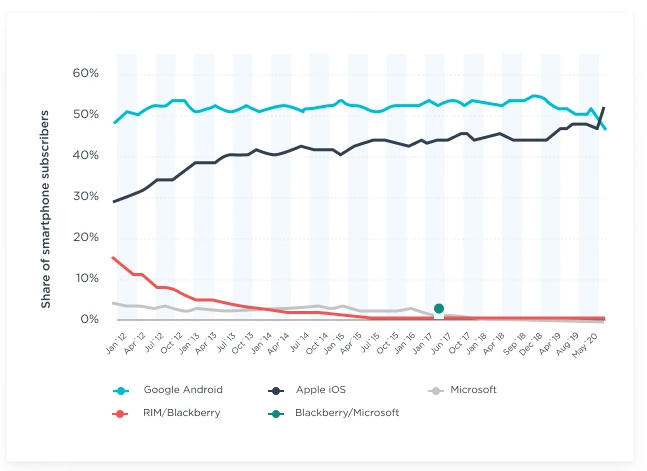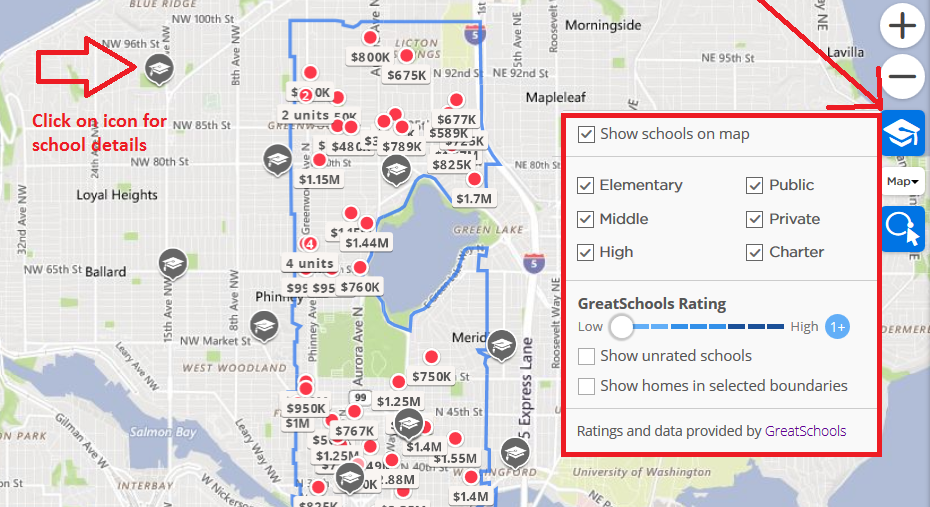View our Guide How to Build a Marketplace in 10 weeks x


The trend for real estate software has conquered the global market by 2023. Not surprisingly, customers prefer digital convenience over traditional offline methods when looking for a home. The real estate in a Digital Age Report 2019 reveals that 44% of home buyers start their research online. The largest part of these netizens is older millennials (98%) and boomers (89%). As to younger boomers, 68% of them actually found a house via a smartphone.
Since millennials make up the largest part of U.S. house buyers, it makes perfect sense to adjust your application to their behavior.
If you want to build a real estate app like Trulia or Zillow, you need to understand what makes up the success of these applications. Let’s find out how you can build a competitive real estate application in this article.
The first advisable step in real estate app development is market & industry analysis. You need to know the current market demand, competition, and anti trends to make your application succeed. Otherwise, how do you know it will bring the expected profit?
As of January 2024, Zillow and Trulia remain among the absolute US market leaders, counting 60 million and 20 million of market visits monthly.

Both companies have similar business models, serving as data-rich engines for property research (Zillow includes 110+ million properties in the USA).
An important fact to note: in 2015, Trulia company was purchased by the Zillow group, becoming the largest real estate agency in the USA. Thanks to this business deal, Zillow almost doubled its user base and could satisfy user demand during the whole home buyer lifecycle. Over the years, the company also merged with other software providers, such as StreetEasy, Agentfolio, and Retsly. This business strategy was highly profitable to the team: in 2018, the application received nearly 186 million of visitors.
Besides the strategy mentioned above, various factors contribute to the success of Zillow. One of them is its customer-centered feature set. Zillow puts user experience first, educating and engaging its audience.
A big part of users navigate the application to learn the house price, a CEO of Zillow Group reveals. A so-called Zestimate is an estimate of a property price based on the public data and the one submitted by users. An intelligent software algorithm uses data from country & tax records. The feed from property listings, history of transactions, house characteristics, and on-market data are some other sources.
Based on these factors, Zestimate calculates the cost of more than 97.5 million houses in U.S. states. Through a comprehensive visualization, users can self-educate on the prices across the states and assume how much their home would cost.
However, the Zestimate feature first caused controversy around homeowners. In the first years of Zillow, there were discussions around whether house prices should become publicly available. The Zillow team responded to it by stating that it’s only the approximate estimation based on public resources. Zillow used this interest for service to their benefit and created a price for each property in the neighborhood. Due to spikes of attention, the service became widely known and used. The median error for its off-market homes is 7.5%, for on-market - 1.9%.
But the fact remains true that the app was the first to introduce a similar feature ever.
Property owners can track their house prices over time using a Zillow app. Home seekers, in turn, get a realistic perception of houses and market info. Based on house style, its location, and previous searches of users, it offers relevant suggestions on properties a user may like.
It may seem tempting to repeat other’s success, although it is impossible. If you are planning to develop a real estate application in 2024, you should differentiate from your competitors and provide a brand new value. By using one of the trends like big data, artificial intelligence, or blockchain to your users’ advantage, you may differentiate from the competitors, but that is not the only solution. Find the gaps in user experience and try to fill them. Interviewing existing Zillow customers can give you the idea of what can be improved and how.

A large variety of factors influence your final app costs. Let’s explore each aspect in more detail.
For instance, developing an application for iOS, Android and web platforms take more time and money than building a single iOS app. On average, creating an app for Android devices is 30% more expensive than iOS app development. Partly, this is due to a variety of OS versions and screen sizes that the Android ecosystem includes.
Therefore, it’s worth specifying the OS and devices you want your app to run on to reach your ideal users.
Speaking about U.S. citizens, Android OS still was dominating the market until 2022. Meanwhile, Apple iOS was steadily growing its market share during the last eight years until it surpassed Android users in 2022. Three of the most used gadgets by real estate companies, according to Real Estate in a Digital Age Report, are smartphones (95%), laptops, and desktop computers (90%).

It’s worth studying the behavioral patterns and OS preferences of your target audience to reach them via the right touchpoints.
What if you need to target both Android and iOS devices? Cross-platform development can save you the time and costs by reusing some code portion.
Secondly, the app functionality and third-party integrations considerably affect the price of your real estate mobile app development. The more complex and unique your solution is, the more time and effort it will take to develop. For instance, learn how we created a mix of CRM, ERP, and a web portal for smart metering companies. The software platform collected the data from IoT devices, stored in the cloud, and presented in a user-friendly format to homeowners and renters.
The more custom integrations your app should include, the higher the final price could be. Location tracking, social media sharing, payment gateways, and MLS listings take time and effort to embed.
In this block, we specified the advisable features for a property buy & sell real estate app. They will definitely affect your real estate mobile app cost.
The more alternative sign up/sign in methods you offer, the easier it will be to navigate your app. In 2023, one can sign up with social media profiles, Google+ accounts, or a biometric touchpoint. To make your app trustworthy, you may want to verify the user's identity via two-step authentication, sending an SMS code to his device, or using his biometrics to sign in. Also, by including seamless guidance with tips along the way, you may guide your audience and make their initial sign up intuitive.
Let your users filter houses by price, location, number of rooms. Trulia includes more than 30 search filters, which opens a new level of flexibility to buyers. One can sort rentals by whether the owners allow cats or dogs, by keyword, property type, and more. Think about how you can simplify lives to users every step of their way. For instance, searching by the date of publishing, neighborhood, parking availability, or house characteristics, a customer can find the best-matching property very fast.

Did you know that photos are the most appreciated features in real estate websites? That is no wonder, as they let you have a realistic presentation of each apartment or house. For a more advanced feature set, you may also add a 360 virtual tour and indoor videos of a specific building. However, integrating a VR feature is a large chunk of work and requires specific skills to implement.
The key is to provide the most detailed information to users while engaging and entertaining them. For example, the Trulia app includes data on 34 neighborhoods, including photos, amenities, and stories from locals. Therefore, users can discover whether local schools fit their requirements, whether the community is friendly, and the level of crime via heatmaps. Sometimes you will need Big Data to provide personalized & relevant info.
Users should be able to add their own properties for sale or rent seamlessly via their control panel. However, if you are planning to build a home search app with the size of Zillow, you need to integrate data from Multiple Listing Services. You may use the IDX system (Internet Data Exchange) to enable this integration. Integrating the data from local US MLS and Zillow API, you can display up-to-date listings without the possibility to store it. RETS technology standard lets you get the necessary information straight to your CRM or application.
Using this feature, users can find the houses nearby displayed on the map. The geo-location uses GPS or Geotags to enable this search. It is a useful option in the real estate search process.
This one is particularly useful to real estate agencies looking to build an application. It helps to track all your leads and sales via a single system, getting real-time analytics about them. Based on this data, you can then craft your marketing & promotion strategies, sending relevant offers and updates. We covered the advantages and the applications of real estate CRMs in this article.

A map is an easy and engaging way to present property info. By using different colors, you can mark the areas with low, medium, or high levels of crime. Mark the risks of natural disasters, the infrastructure nearby, and the costs of properties across the regions. Besides this, consider clustering your markers to avoid overcrowding your map with too much information. Let your users choose how much information they want to see by selecting the search criteria. Important note: besides offering a map view, include the list view of houses for an increased commodity of service.
Some applications let you calculate the interest rates for a home loan. Others include a calculator of a property price based on the loan amount, taxes, and some other factors. You can also integrate push-notifications to alert a user once an appropriate item appears.
Let users close a deal by contacting a real estate agent directly via the app. Let him know the online status of the interested party. Via online conversations, users can get more details about a specific property and move down a sales funnel. For you, it means more deals and faster sales processes.
These are some of the must-haves of an intuitive real estate mobile application to buy or sell properties. You may also add the Preferred Items feature, the AI-powered recommendation engine, and the currency manager to choose the currency you need.
However, avoid overcrowding your application. Adding just one feature that your competitors don’t have doesn’t guarantee the success of your solution. That is why you don’t need to have all the feature set in place that others have. Features are just small puzzles that make up the final picture.
A web version is helpful to supervise all the users, deals, and control them with ease. Here are some features you should include in your administrator panel:
Besides a control panel, some back-end development work will be necessary. Sometimes, you will need to integrate MLS APIs, create your own APIs, create push-notifications. Besides, storing your data on the cloud servers like AWS or Azure ensures its security but affects your costs.
Other factors influencing your app development cost are the team size and country you work. For example, an hourly rate in the USA of a developer is $110-150/hour. In Germany, it is $35-55/hour, and in Ukraine, $30-35/hour. $30-35/hour.

For example, to build a mobile app present on all three mobile operating systems, you will require at least one iOS developer, one Android developer, a QA engineer, a UI & UX designer, and one project manager. If you plan to have a web version of your app as well, a back-end and a front-end developer will be required.
From the technological standpoint, the final cost of your real estate app development includes:
Hours spent * Average hourly rate of your employees = Development Price
An application like Zillow or Trulia takes at least 700 hours to develop. Therefore, assuming that an average hourly rate of your employees is $30, a similar mobile application will cost you around $21 000.
If you are planning to have a website version as well, it will require another skill set and more time to develop. Assuming that your mobile + web app development takes 1200 hours of work, including MLS integration, database development, and APIs, it will cost $36 000 to build it from zero. If you hire a team in the USA of Western Europe, the numbers will be totally different.
Note! This number is an approximate estimation since the final price will depend on the feature set, target devices, and other requirements specific to your project.
Note! This number is an approximate estimation since the final price will depend on the feature set, target devices, and other requirements specific to your project.
Before starting to develop any application, make sure that it is worth building. Test your assumptions within focus groups, or take a survey on what customers require the most.
Real estate applications like Zillow offer fast and enjoyable house selling experience. You can make your application that will bring a ton of usefulness. Just drop us a line, and make your bravest idea a reality.